window Citroen C3 PICASSO RHD 2011.5 1.G Owner's Manual
[x] Cancel search | Manufacturer: CITROEN, Model Year: 2011.5, Model line: C3 PICASSO RHD, Model: Citroen C3 PICASSO RHD 2011.5 1.GPages: 244, PDF Size: 8.29 MB
Page 2 of 244
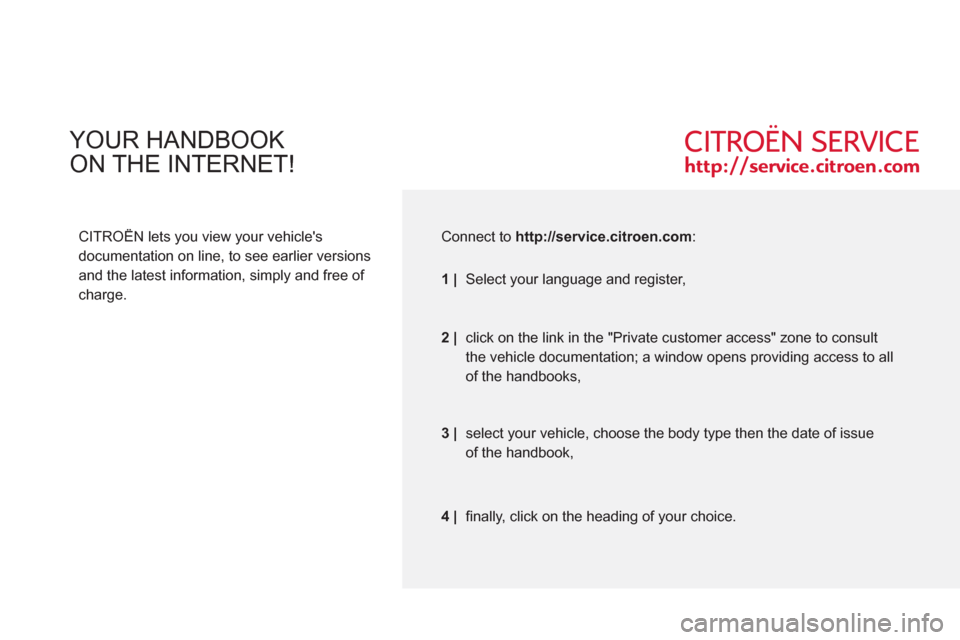
YOUR HANDBOOK
ON THE INTERNET!
CITROËN lets you view your vehicle's
documentation on line, to see earlier versions
and the latest information, simply and free of
charge.
Connect to http://service.citroen.com
:
1|
Select your language and register,
click on the link in the "Private customer access" zone to consult
the vehicle documentation; a window opens providing access to all
of the handbooks,
select your vehicle, choose the body type then the date of issue
of the handbook,
fi nally, click on the heading of your choice.
2|
3 |
4 |
Page 4 of 244
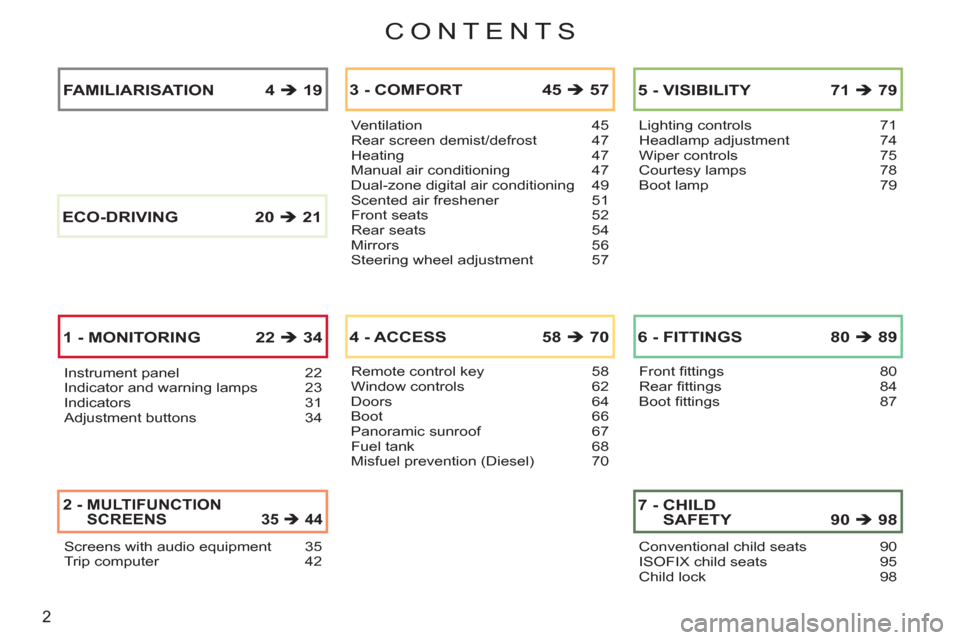
2
CONTENTS
Instrument panel 22Indicator and warning lamps 23Indicators 31Adjustment buttons 34
Ventilation 45Rear screen demist/defrost 47Heating 47Manual air conditioning 47Dual-zone digital air conditioning 49Scented air freshener 51Front seats 52Rear seats 54Mirrors 56Steering wheel adjustment 57
3 - COMFORT 45 �Π57
Remote control key 58Window controls 62Doors 64Boot 66Panoramic sunroof 67Fuel tank 68Misfuel prevention (Diesel) 70
4 - ACCESS 58 �Π70
Lighting controls 71Headlamp adjustment 74Wiper controls 75Courtesy lamps 78Boot lamp 79
5 - VISIBILITY 71�Î79
Conventional child seats 90ISOFIX child seats 95Child lock 98
7 - CHILD
SAFETY 90�Î98
FAMILIARISATION 4�Π19
1 - MONITORIN
G22�Π34
Screens with audio equipment 35Trip computer 42
2 - MULTIFUNCTION
SCREENS 35 �Î44
Front fi ttings 80Rear fi ttings 84Boot fi ttings 87
6 - FITTINGS 80�Î89 ECO-DRIVING 20
�Î21
Page 10 of 244
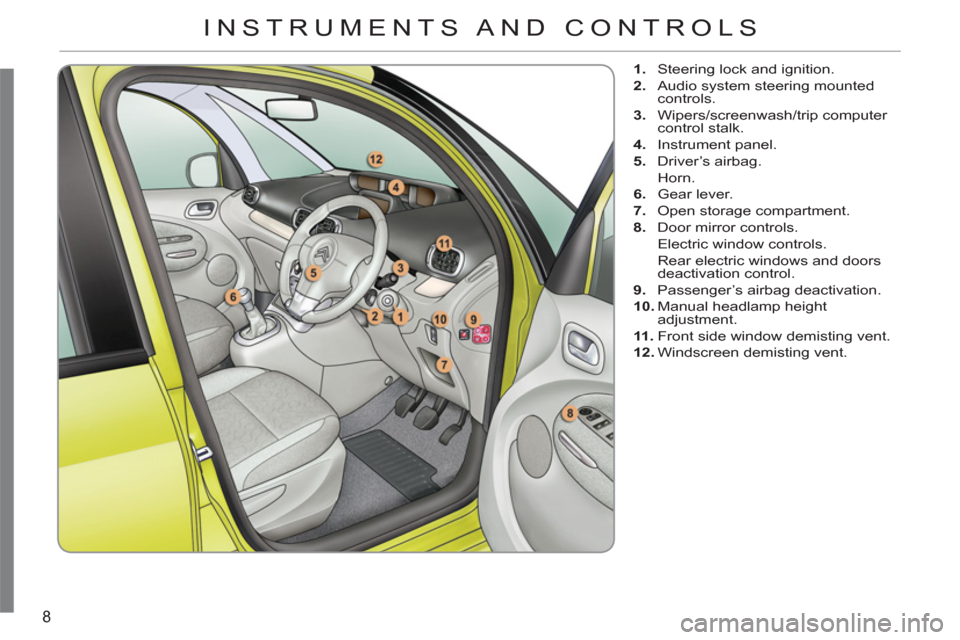
8
1.
Steering lock and ignition.
2.
Audio system steering mounted
controls.
3.
Wipers/screenwash/trip computer
control stalk.
4.
Instrument panel.
5.
Driver’s airbag.
Horn.
6.
Gear lever.
7.
Open storage compartment.
8.
Door mirror controls.
Electric window controls.
Rear electric windows and doors
deactivation control.
9.
Passenger’s airbag deactivation.
10.
Manual headlamp height
adjustment.
11 .
Front side window demisting vent.
12.
Windscreen demisting vent.
INSTRUMENTS AND CONTROLS
Page 22 of 244
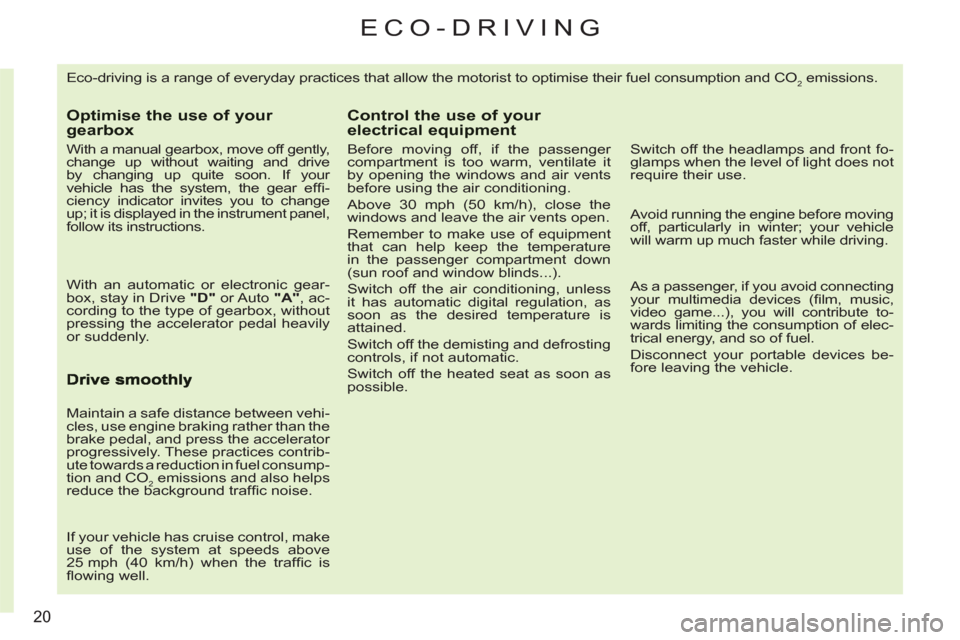
20
ECO-DRIVING
Eco-driving is a range of everyday practices that allow the motorist to optimise their fuel consumption and CO2 emissions.
Optimise the use of your gearbox
With a manual gearbox, move off gently,
change up without waiting and drive
by changing up quite soon. If your
vehicle has the system, the gear effi -
ciency indicator invites you to change
up; it is displayed in the instrument panel,
follow its instructions.
With an automatic or electronic gear-
box, stay in Drive "D"
or Auto "A"
, ac-
cording to the type of gearbox, without
pressing the accelerator pedal heavily
or suddenly.
Maintain a safe distance between vehi-
cles, use engine braking rather than the
brake pedal, and press the accelerator
progressively. These practices contrib-
ute towards a reduction in fuel consump-
tion and CO
2 emissions and also helps
reduce the background traffi c noise.
If your vehicle has cruise control, make
use of the system at speeds above
25 mph (40 km/h) when the traffi c is
fl owing well.
Control the use of your electrical equipment
Before moving off, if the passenger
compartment is too warm, ventilate it
by opening the windows and air vents
before using the air conditioning.
Above 30 mph (50 km/h), close the
windows and leave the air vents open.
Remember to make use of equipment
that can help keep the temperature
in the passenger compartment down
(sun roof and window blinds...).
Switch off the air conditioning, unless
it has automatic digital regulation, as
soon as the desired temperature is
attained.
Switch off the demisting and defrosting
controls, if not automatic.
Switch off the heated seat as soon as
possible.
Switch off the headlamps and front fo-
glamps when the level of light does not
require their use.
Avoid running the engine before moving
off, particularly in winter; your vehicle
will warm up much faster while driving.
As a passenger, if you avoid connecting
your multimedia devices (fi lm, music,
video game...), you will contribute to-
wards limiting the consumption of elec-
trical energy, and so of fuel.
Disconnect your portable devices be-
fore leaving the vehicle.
Page 24 of 244
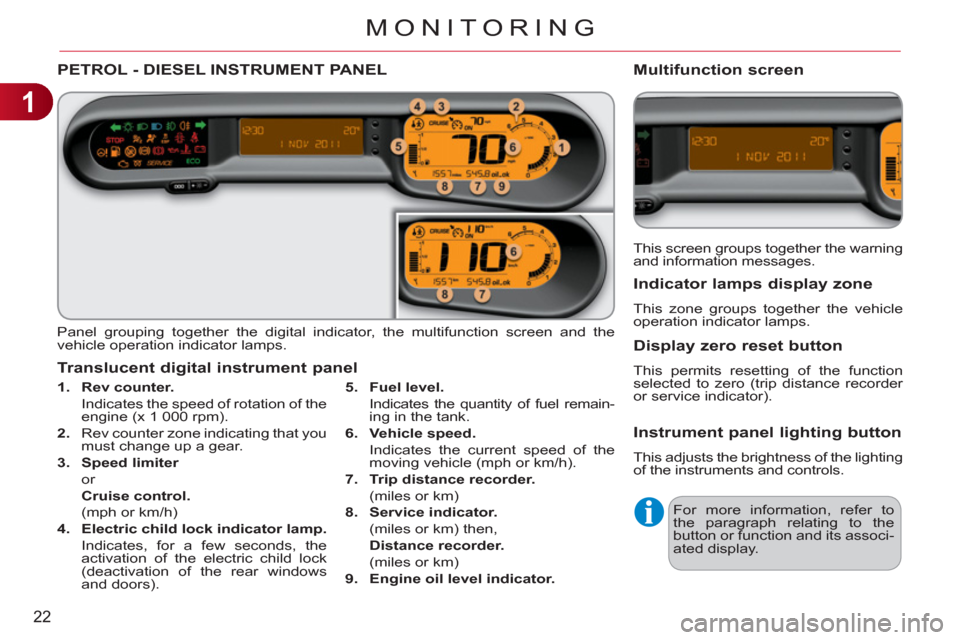
1
22
MONITORING
PETROL - DIESEL INSTRUMENT PANEL
Panel grouping together the digital indicator, the multifunction screen and the
vehicle operation indicator lamps.
1.
Rev counter.
Indicates the speed of rotation of the
engine (x 1 000 rpm).
2.
Rev counter zone indicating that you
must change up a gear.
3.
Speed limiter
or
Cruise control.
(mph or km/h)
4.
Electric child lock indicator lamp.
Indicates, for a few seconds, the
activation of the electric child lock
(deactivation of the rear windows
and doors).
Translucent digital instrument panel
This screen groups together the warning
and information messages.
Multifunction screen
Indicator lamps displa
y zone
This zone groups together the vehicle
operation indicator lamps.
Display zero reset button
This permits resetting of the function
selected to zero (trip distance recorder
or service indicator).
Instrument panel lighting button
This adjusts the brightness of the lighting
of the instruments and controls.
For more information, refer to
the paragraph relating to the
button or function and its associ-
ated display.
5.
Fuel level.
Indicates the quantity of fuel remain-
ing in the tank.
6.
Vehicle speed.
Indicates the current speed of the
moving vehicle (mph or km/h).
7.
Trip distance recorder.
(miles or km)
8.
Service indicator.
(miles or km) then,
Distance recorder.
(miles or km)
9.
Engine oil level indicator.
Page 47 of 244
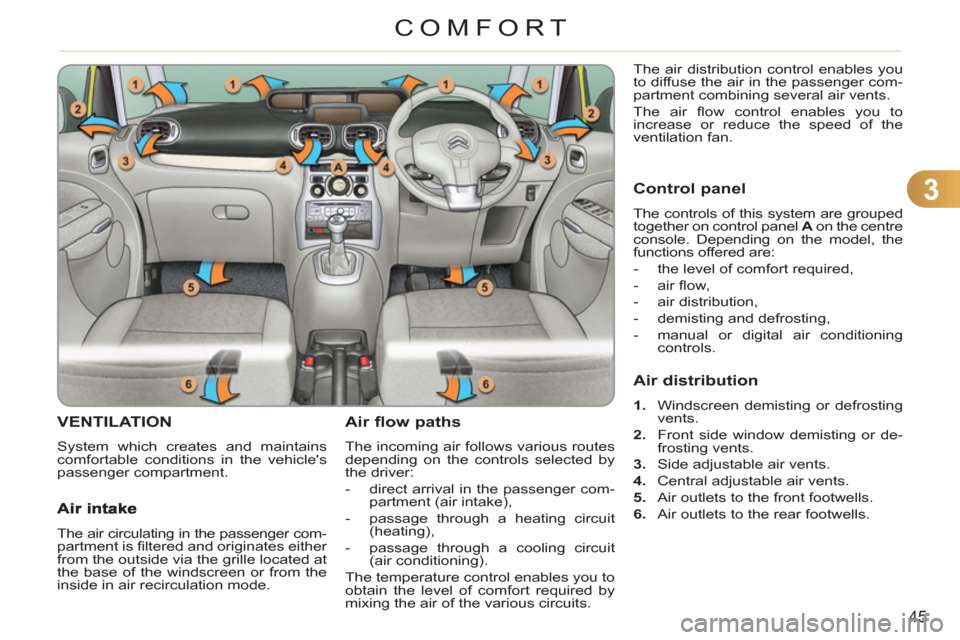
3
45
COMFORT
VENTILATION
System which creates and maintains
comfortable conditions in the vehicle's
passenger compartment.
Air flow paths
The incoming air follows various routes
depending on the controls selected by
the driver:
- direct arrival in the passenger com-
partment (air intake),
- passage through a heating circuit
(heating),
- passage through a cooling circuit
(air conditioning).
The temperature control enables you to
obtain the level of comfort required by
mixing the air of the various circuits. The air distribution control enables you
to diffuse the air in the passenger com-
partment combining several air vents.
The air fl ow control enables you to
increase or reduce the speed of the
ventilation fan.
The air circulating in the passenger com-
partment is fi ltered and originates either
from the outside via the grille located at
the base of the windscreen or from the
inside in air recirculation mode.
Control panel
The controls of this system are grouped
together on control panel A
on the centre
console. Depending on the model, the
functions offered are:
- the level of comfort required,
- air fl ow,
- air distribution,
- demisting and defrosting,
- manual or digital air conditioning
controls.
Air distribution
1.
Windscreen demisting or defrosting
vents.
2.
Front side window demisting or de-
frosting vents.
3.
Side adjustable air vents.
4.
Central adjustable air vents.
5.
Air outlets to the front footwells.
6.
Air outlets to the rear footwells.
Page 49 of 244
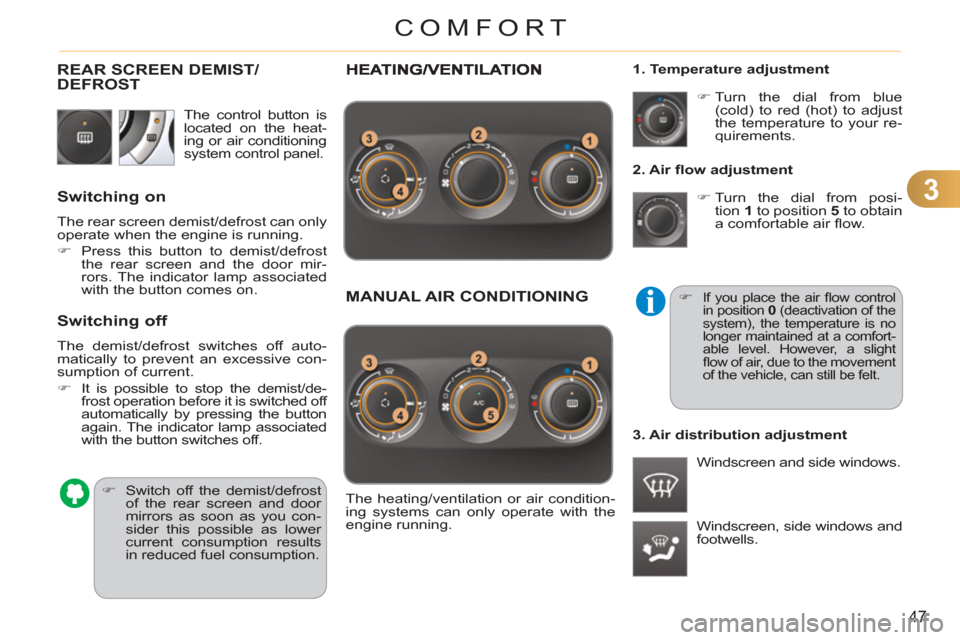
3
47
COMFORT
2. Air fl ow adjustment
�)
Turn the dial from posi-
tion 1
to position 5
to obtain
a comfortable air fl ow.
Windscreen, side windows and
footwells.
�)
Turn the dial from blue
(cold) to red (hot) to adjust
the temperature to your re-
quirements.
Windscreen and side windows.
1. Temperature adjustment
The heating/ventilation or air condition-
ing systems can only operate with the
engine running.
�)
If you place the air fl ow control
in position 0
(deactivation of the
system), the temperature is no
longer maintained at a comfort-
able level. However, a slight
fl ow of air, due to the movement
of the vehicle, can still be felt.
3. Air distribution adjustment
MANUAL AIR CONDITIONING
The control button is
located on the heat-
ing or air conditioning
system control panel.
REAR SCREEN DEMIST/DEFROST
�)
Switch off the demist/defrost
of the rear screen and door
mirrors as soon as you con-
sider this possible as lower
current consumption results
in reduced fuel consumption.
Switching on
The rear screen demist/defrost can only
operate when the engine is running.
�)
Press this button to demist/defrost
the rear screen and the door mir-
rors. The indicator lamp associated
with the button comes on.
Switching off
The demist/defrost switches off auto-
matically to prevent an excessive con-
sumption of current.
�)
It is possible to stop the demist/de-
frost operation before it is switched off
automatically by pressing the button
again. The indicator lamp associated
with the button switches off.
Page 50 of 244
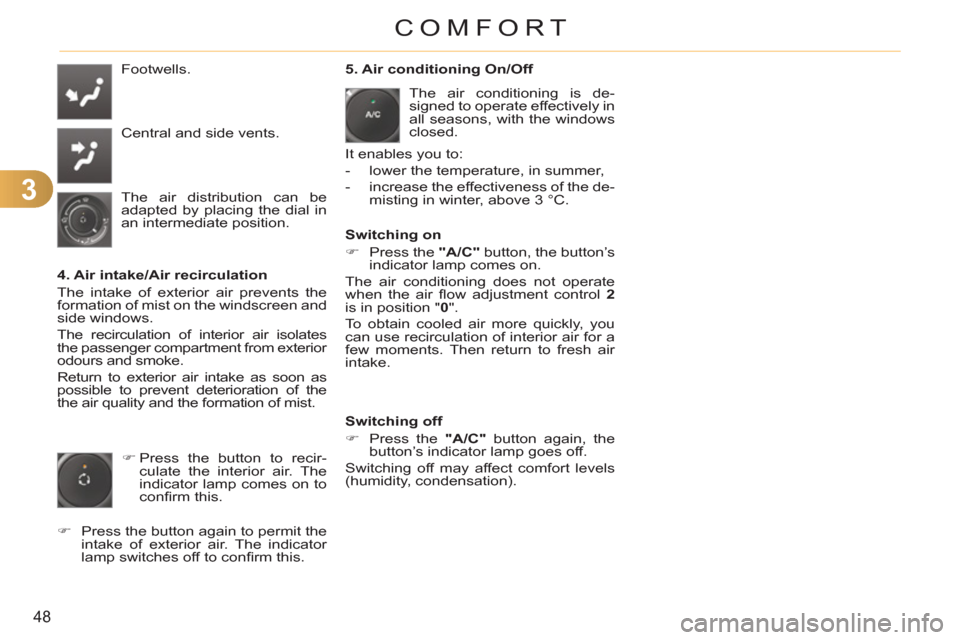
3
48
COMFORT
Footwells.
Central and side vents.
The air distribution can be
adapted by placing the dial in
an intermediate position.
4. Air intake/Air recirculation
The intake of exterior air prevents the
formation of mist on the windscreen and
side windows.
The recirculation of interior air isolates
the passenger compartment from exterior
odours and smoke.
Return to exterior air intake as soon as
possible to prevent deterioration of the
the air quality and the formation of mist.
�)
Press the button to recir-
culate the interior air. The
indicator lamp comes on to
confi rm this.
�)
Press the button again to permit the
intake of exterior air. The indicator
lamp switches off to confi rm this.
5. Air conditioning On/Off
It enables you to:
- lower the temperature, in summer,
- increase the effectiveness of the de-
misting in winter, above 3 °C.
Switching off
�)
Press the "A/C"
button again, the
button’s indicator lamp goes off.
Switching off may affect comfort levels
(humidity, condensation).
The air conditioning is de-
signed to operate effectively in
all seasons, with the windows
closed.
Switching on
�)
Press the "A/C"
button, the button’s
indicator lamp comes on.
The air conditioning does not operate
when the air fl ow adjustment control 2
is in position " 0
".
To obtain cooled air more quickly, you
can use recirculation of interior air for a
few moments. Then return to fresh air
intake.
Page 51 of 244
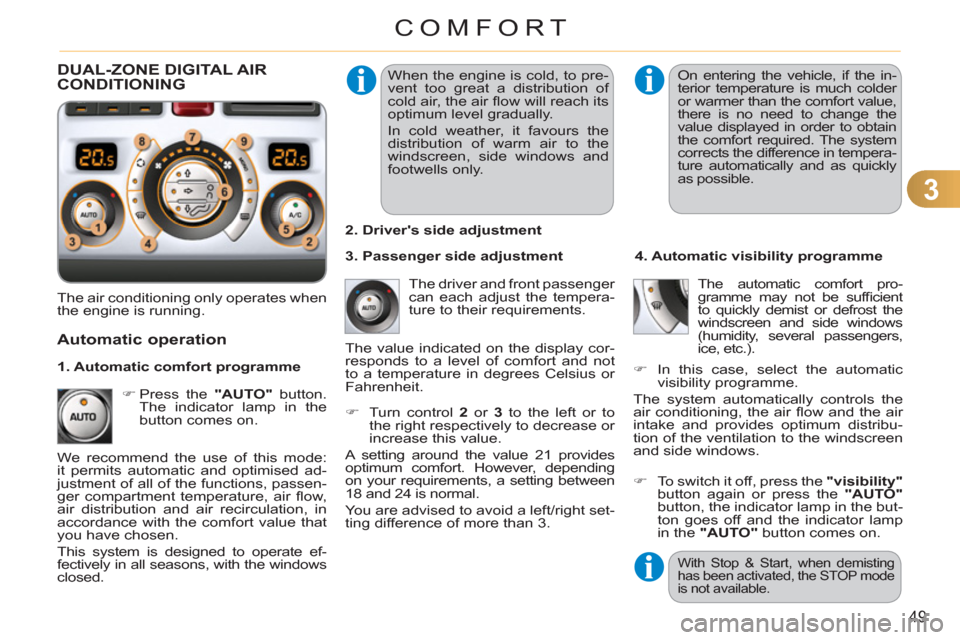
3
49
COMFORT
When the engine is cold, to pre-
vent too great a distribution of
cold air, the air fl ow will reach its
optimum level gradually.
In cold weather, it favours the
distribution of warm air to the
windscreen, side windows and
footwells only. On entering the vehicle, if the in-
terior temperature is much colder
or warmer than the comfort value,
there is no need to change the
value displayed in order to obtain
the comfort required. The system
corrects the difference in tempera-
ture automatically and as quickly
as possible.
The air conditioning only operates when
the engine is running. The driver and front passenger
can each adjust the tempera-
ture to their requirements.
�)
Turn control 2
or 3
to the left or to
the right respectively to decrease or
increase this value.
A setting around the value 21 provides
optimum comfort. However, depending
on your requirements, a setting between
18 and 24 is normal.
You are advised to avoid a left/right set-
ting difference of more than 3.
4. Automatic visibility programme
The automatic comfort pro-
gramme may not be suffi cient
to quickly demist or defrost the
windscreen and side windows
(humidity, several passengers,
ice, etc.).
�)
In this case, select the automatic
visibility programme.
The system automatically controls the
air conditioning, the air fl ow and the air
intake and provides optimum distribu-
tion of the ventilation to the windscreen
and side windows.
Automatic operation
�)
Press the "AUTO"
button.
The indicator lamp in the
button comes on.
2. Driver's side adjustment
DUAL-ZONE DIGITAL AIR
CONDITIONING
We recommend the use of this mode:
it permits automatic and optimised ad-
justment of all of the functions, passen-
ger compartment temperature, air fl ow,
air distribution and air recirculation, in
accordance with the comfort value that
you have chosen.
This system is designed to operate ef-
fectively in all seasons, with the windows
closed. The value indicated on the display cor-
responds to a level of comfort and not
to a temperature in degrees Celsius or
Fahrenheit.
�)
To switch it off, press the "visibility"
button again or press the "AUTO"
button, the indicator lamp in the but-
ton goes off and the indicator lamp
in the "AUTO"
button comes on.
1. Automatic comfort programme
3. Passenger side adjustment
With Stop & Start, when demisting
has been activated, the STOP mode
is not available.
Page 52 of 244
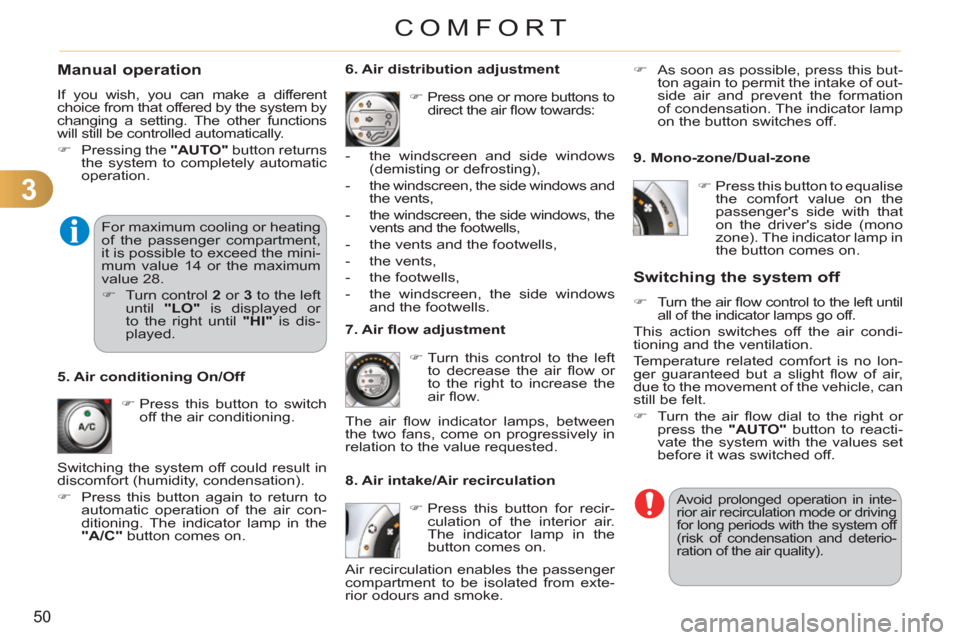
3
50
COMFORT
Manual operation
If you wish, you can make a different
choice from that offered by the system by
changing a setting. The other functions
will still be controlled automatically.
�)
Pressing the "AUTO"
button returns
the system to completely automatic
operation.
�)
Press this button to switch
off the air conditioning.
6. Air distribution adjustment
�)
Press one or more buttons to
direct the air fl ow towards:
7. Air fl ow adjustment
�)
Turn this control to the left
to decrease the air fl ow or
to the right to increase the
air fl ow.
8. Air intake/Air recirculation
Switching the system off
�)
Turn the air fl ow control to the left until
all of the indicator lamps go off.
This action switches off the air condi-
tioning and the ventilation.
Temperature related comfort is no lon-
ger guaranteed but a slight fl ow of air,
due to the movement of the vehicle, can
still be felt.
�)
Turn the air fl ow dial to the right or
press the "AUTO"
button to reacti-
vate the system with the values set
before it was switched off.
�)
Press this button for recir-
culation of the interior air.
The indicator lamp in the
button comes on.
5. Air conditioning On/Off
Avoid prolonged operation in inte-
rior air recirculation mode or driving
for long periods with the system off
(risk of condensation and deterio-
ration of the air quality).
- the windscreen and side windows
(demisting or defrosting),
- the windscreen, the side windows and
the vents,
- the windscreen, the side windows, the
vents and the footwells,
- the vents and the footwells,
- the vents,
- the footwells,
- the windscreen, the side windows
and the footwells.
The air fl ow indicator lamps, between
the two fans, come on progressively in
relation to the value requested.
�)
As soon as possible, press this but-
ton again to permit the intake of out-
side air and prevent the formation
of condensation. The indicator lamp
on the button switches off.
For maximum cooling or heating
of the passenger compartment,
it is possible to exceed the mini-
mum value 14 or the maximum
value 28.
�)
Turn control 2
or 3
to the left
until "LO"
is displayed or
to the right until "HI"
is dis-
played.
9. Mono-zone/Dual-zone
�)
Press this button to equalise
the comfort value on the
passenger's side with that
on the driver's side (mono
zone). The indicator lamp in
the button comes on.
Air recirculation enables the passenger
compartment to be isolated from exte-
rior odours and smoke. Switching the system off could result in
discomfort (humidity, condensation).
�)
Press this button again to return to
automatic operation of the air con-
ditioning. The indicator lamp in the
"A/C"
button comes on.